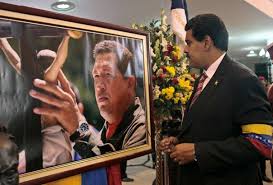 Though he died a year ago, Hugo Chavez still presents a weekly show on Venezuelan state television.
Though he died a year ago, Hugo Chavez still presents a weekly show on Venezuelan state television.
In the last episode, he showed off poverty reduction data, railed at the “bourgeoisie” for looting the nation’s oil wealth, and accused the opposition of fomenting instability during an hours-long monologue from the presidential palace.
The weekly retransmission of Chavez’s famous “Hello President!” program is just one example of how his successor, President Nicolas Maduro, has kept the socialist leader’s image alive ever since his March 5, 2013, death from cancer at age 58.
Elsewhere, a stylized image of Chavez’s eyes – reminiscent of an Andy Warhol print – watches Venezuelans from murals in the barrios of Caracas and T-shirts worn by supporters.
His trademark squiggly signature looms large on the sides of scores of apartment buildings put up under the government’s “Great Housing Mission” begun toward the end of his 14-year rule.
Many official ceremonies begin with a recording of his booming voice singing the national anthem, reducing some supporters to tears. During the recent protests against Maduro, riot police have even been using loudspeakers to blast a popular song interpreted by the late leader at protesters.
Calling himself Chavez’s “son,” Maduro constantly cites the “eternal Comandante” in his speeches. He even appears to have adopted his theatrical gestures, dramatic voice cadence, and habits of signing important documents in public on live TV.
Nowhere is devotion to Chavez felt stronger than in the January 23 neighborhood, a humble pro-government stronghold on the slopes of western Caracas overlooking the Miraflores presidential palace. The president is buried there.
‘ST. CHAVEZ’
“For us, the supreme comandante didn’t die,” said Elizabeth Torres, a 49-year-old who maintains a roadside altar dedicated to “St. Hugo Chavez” near the mausoleum where his remains lie.
“He lives in each of our hearts.”
Every day at 4:25 p.m., a cannon reminds January 23 residents of the exact time of Chavez’s death while his face adorns walls all over the neighborhood.
One large mural depicts the former president as one of Jesus’ disciples, alongside leftist icons such as Ernesto “Che” Guevara, Karl Marx and Fidel Castro.
Chavez ruled Venezuela for 14 years and used the country’s oil riches to finance social programs that benefited millions of the country’s poor.
But he also alienated many Venezuelans who saw the former paratrooper as an authoritarian, squandering the country’s resources and harassing the private sector to try to replicate Cuba’s Communist model.
The deteriorating economic situation since Maduro took office 11 months ago helped trigger a wave of anti-government protests that have left at least 18 people dead in the last month.
On top of that, inflation, shortages of basic products and insecurity have begun to irritate the “Chavista” power-base.
“If Chavez were alive, we wouldn’t be going through what we are going through now,” said Jakeline Arrieta, who had brought her two young sons from across the city to visit the mausoleum.
“I don’t agree with the use of his name, his image like this,” added the 45-year-old. “Maduro should rely on his own personality rather than that of Chavez.”
Critics argue that the former union leader and bus driver exploits the image of Chavez to cover up his own weaknesses.
“He’s a very bad imitation,” opposition leader Henrique Capriles told Reuters.
But altar guardian Torres, who every few days puts a cup of coffee next to a bust of the once caffeine-addicted Chavez, says she is not concerned because her hero is watching over.
“The Comandante guides Maduro from heaven,” she said.
“Every day, more people are tolerating Maduro a little more, loving him a little more or at least accepting him. We will never stop fighting for the legacy left to us by the supreme comandante.”
Reuters
Leave a Reply
You must be logged in to post a comment.